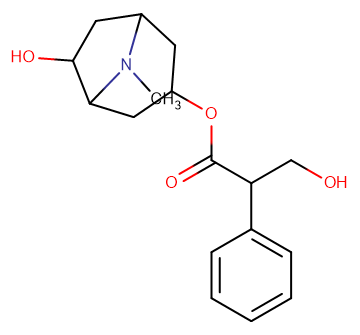
Anisodamine
CAS No. 17659-49-3
Anisodamine( 6-hydroxy Hyoscyamine )
Catalog No. M12660 CAS No. 17659-49-3
Anisodamine, also known as 7β-hydroxyhyoscyamine, is an anticholinergic and α1-adrenergic receptor antagonist.
Purity : >98% (HPLC)
 COA
COA
 Datasheet
Datasheet
 HNMR
HNMR
 HPLC
HPLC
 MSDS
MSDS
 Handing Instructions
Handing Instructions
| Size | Price / USD | Stock | Quantity |
| 100MG | 38 | In Stock |


|
| 200MG | Get Quote | In Stock |


|
| 500MG | Get Quote | In Stock |


|
| 1G | Get Quote | In Stock |


|
Biological Information
-
Product NameAnisodamine
-
NoteResearch use only, not for human use.
-
Brief DescriptionAnisodamine, also known as 7β-hydroxyhyoscyamine, is an anticholinergic and α1-adrenergic receptor antagonist.
-
DescriptionAnisodamine, also known as 7β-hydroxyhyoscyamine, is an anticholinergic and α1-adrenergic receptor antagonist used in the treatment of acute circulatory shock in China. It is also a naturally occurring tropane alkaloid found in some plants of the Solanaceae family.
-
In Vitro——
-
In Vivo——
-
Synonyms6-hydroxy Hyoscyamine
-
PathwayEndocrinology/Hormones
-
TargetAdrenergic Receptor
-
RecptorAdrenergic Receptor
-
Research Area——
-
Indication——
Chemical Information
-
CAS Number17659-49-3
-
Formula Weight305.38
-
Molecular FormulaC17H23NO4
-
Purity>98% (HPLC)
-
SolubilityDMSO: 10 mM
-
SMILESCN1C2CC(O)C1CC(C2)OC(=O)C(CO)C1=CC=CC=C1
-
Chemical Name——
Shipping & Storage Information
-
Storage(-20℃)
-
ShippingWith Ice Pack
-
Stability≥ 2 years
Reference
1.Zhang WW, et al. Neurosci Lett. 2008 Oct 10;443(3):241-5.
molnova catalog



related products
-
Tamsulosin hydrochlo...
Tamsulosin is a selective antagonist at alpha-1A and alpha-1B-adrenoceptors in the prostate, prostatic capsule, prostatic urethra, and bladder neck.
-
Alfuzosin hydrochlor...
Alfuzosin hydrochloride is an?α1 adrenergic receptor?antagonist used to treat benign prostatic hyperplasia (BPH).
-
Orciprenaline sulfat...
A beta-2 adrenergic agonist used in the treatment of ASTHMA and BRONCHIAL SPASM.



 Cart
Cart
 sales@molnova.com
sales@molnova.com


